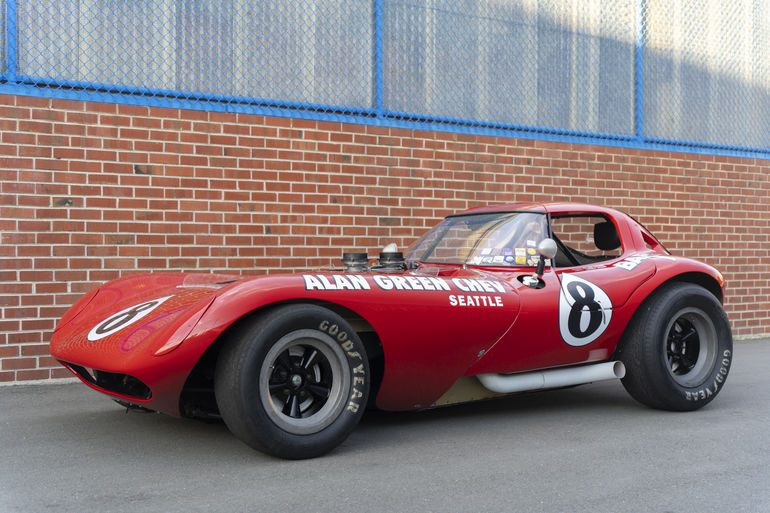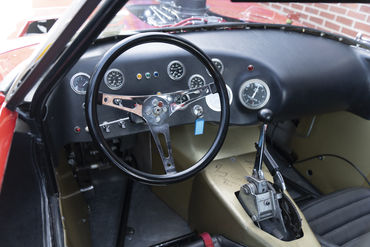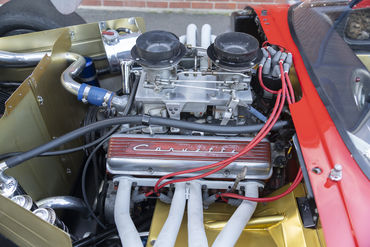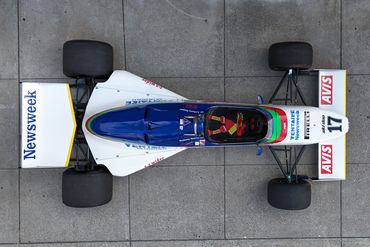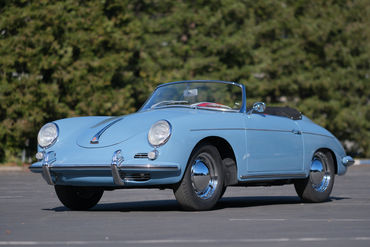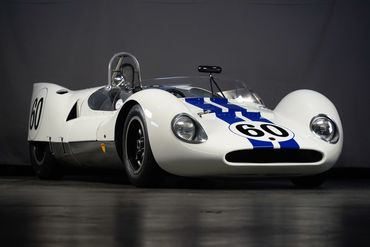Sold
SOLD 04/23
1964 Bill Thomas
Cheetah
Iconic 1964 Cheetah, Chevrolet’s answer to the Cobra. Same owner last thirty one years, much documentation, multi year history at Monterey Rolex Reunion and other Vintage events. Sold on a California title.
- VINBTC003
- Exterior ColorRed
- Interior ColorBlack
- MileageTMU
- Engine6.2L Chevy V8
- Transmission4-speed manual
- StatusSold
- StockFJ2549
Description
1964 Cheetah
s/n BTC003
Red with “Alan Green Chevrolet” Period Racing Livery
Bill Thomas Cheetah History
During the heyday of American sports car racing, there was no more volatile crucible for performance innovation than Southern California. The 1960s heated up as racetracks popped up all over the west coast and pioneers of motorsports set up shops to build some of the fastest cars in the world. Initially conceived as a direct competitor to the Shelby Cobra, the Cheetah was designed and developed by Bill Thomas and Don Edmunds. Though only a two-year venture, from 1963-1965, the small shop in Anaheim, CA managed to build these potent race cars into legendary competitors. Of course, a great deal of the success behind the Cheetah was in the fuel-injected Chevrolet engine, situated far back into the mid-section of the car, creating a near perfect 50/50 weight balance. The astonishing power to weight ratio and fantastic cornering capability made the Cheetah agile and scathingly fast. Had all this been built under a docile open roadster body, most likely the Cheetah would have become one of many long forgotten limited production sports racers from this period. But the menacing body design with its lurid fenders, high-arched rear haunch roofline, and dramatic gullwing doors left every onlooker gaping with slack-jawed awe at the sight of a Cheetah on the racetrack.
Thomas and Edmunds were no strangers to racing so when Bill Thomas to build a car, it was natural that it would utilize GM power, it was no surprise that the high-revving Corvette 327 V8 engine and durable 4-speed transmission would find its way into the Cheetah. But nearly as quickly as the first cars were built, homologation rules changed and GM pulled the plug, leaving the team stranded with no backing. Despite losing funding and a tragic fire at the shop where Cheetahs were built, the company briefly soldiered on, even allowing for fiberglass body shells to be independently built by Fiberglass Trends, offering it from 1965 well into the 1980s. During construction of the original Cheetahs, Thomas and Edmunds had done a great job building the chassis, utilizing upper and lower tubular A-arms, rear trailing arm suspension, coil over shocks and, as it was 1963 and GM had not developed a production disc brake, drum brakes were fitted at all four corners. The total package including the handmade fiberglass body weighed in at 1,700 lbs. This, combined with race-tuning, special cams, crank stroke, and Thomas modified dual air meter Rochester Fuel Injection made for well over 400hp in race trim, making the Cheetah a formidable competitor in a wide range of venues.
Even though the Cheetah was quick, it could not outpace the speed of racing technology and the shift to mid-engine production. Eventually Thomas and Edmunds closed the doors and moved on to other ventures. Of the eleven first generation factory-built Cheetahs, assembled as complete cars, historians generally agree that the first two cars were built with aluminum bodies constructed by California Metal Shaping (one of which was rebodied later in fiberglass). Nine additional examples were built after the first two using fiberglass bodies supplied by Contemporary Fiberglass Company. As many as 33 fiberglass bodies were believed to have been molded in period with 19 chassis constructed at the original shop by Thomas and Edmunds, including the stillborn 427 powered “Super Cheetah” produced near the end of production. It is not known how many of the spare chassis constructed in period were used as replacements for damaged race cars, however the practice of building spare chassis was typical for nearly all racing establishments.
The History of BTC003
This Cheetah is believed to have been part of the three original first-generation production Bill Thomas Cheetahs delivered in time for the American Challenge Cup held on February 15, 1964, at Daytona International Raceway. Although specific factory ledgers don’t exist for the frames and bodies produced, the first series Cheetahs have been generally identified by several experts due to their unique construction. This car is believed to have been one of two cars delivered to Alan Green Chevrolet in Seattle, Washington. Reportedly the first of those delivered, it was prepared for race duty, the car was painted with Alan Green Chevrolet livery and sent racing. Alan Green Chevrolet is well documented in Cheetah history and represents a big part of the racing achievements these cars earned in 1964 and 1965 during period racing.
During the racing years, well-known driver Allen Grant participated in ten races during the 1964 racing season, from May 10, 1964 (USRRC at Pacific Raceway) through October 18, 1964 (Monterey Grand Prix at Laguna Seca). IN the 1964 season, both Allen Grant and Jerry Grant achieved four 1st place finishes Vintage Corvette expert and Fuel Injection guru Larry Webb, also a driver for Green, was the chief mechanic for the Alan Green Cheetah during the period Green campaigned the car.
While under race duty, the car is believed to have been first outfitted with a yellow body wearing #17. Wearing this livery, the car crashed at Daytona during practice, causing significant damage to the frame. The car was returned to Thomas’ shop and a new frame was fitted along with a new body finished in red. Wearing Alan Green Chevrolet racing graphics and #8, the Cheetah went on to compete at club events and various period racing venues with both Allen Grant and Gary Grant at the wheel. With little to no manufacturer’s support, the notoriously fast Cheetah was a wicked handful even for top drivers. Local racing expert Trevor Harris, later of AVS-Shadow Can-Am car fame, was asked to improve the handling which he did via a new trailing arm design and tubes to stiffen the chassis. A larger capacity radiator and new hood vents were added by Larry Webb to help air flow and to exhaust the historically hot footboxes Cheetah drivers suffered from sitting so close to the engine headers. Later that same year, Green repainted the car dark green and continued to campaign the car in various road races and drag races, reportedly running 10 second quarter miles at 134mph.
In 1966, Alan Green Chevrolet sold the car to Jerry Copely, Medford, OR who painted it purple and raced it locally that year, winning the SCCA Regional Championship for his class before selling it to Barrie Grant, Grants Pass, OR in 1967. Barrie Grant raced the car in both yellow and blue livery through 1970 earning two more SCCA Regional Championships before selling the car to Rob Pinkham, Lake Tahoe, CA in 1972. During Pinkham’s ownership the Cheetah was treated toa a decade-long restoration configuring it for street use including adding turn indicators, a horn, and a windshield wiper. As part of his restoration objectives, Pinkham intended to obtain title and registration for street driving. In 1982, Pinkham contacted Thomas, who by then had become somewhat recalcitrant regarding the outcome of the Cheetah venture and offered no guidance regarding a vehicle ID number for his car. Pinkham, eager to solve his dilemma, surmised by counting forward from the first and second fiberglass bodied Cheetahs Bill Thomas produced before Alan Green purchased his car, deduced that his car was #3 and, despite historic reference supporting Cheetah frame number assignment, welded the numbers “BTC003” to the front cross member of the frame and received license and title using the chassis number still present on the car. After completing the restoration, Pinkham showed the car at various concours and vintage events eventually selling it to the current consigning owner in 1989.
Upon purchasing the car, the current owner, aware of the rarity of the body shell, removed it from the chassis, and safely stored it in his garage. An unused original fiberglass Cheetah body was located and refinished with only minor repairs required to a small section of the rear of the car. The new body was painted red, and period correct Alan Green Chevrolet livery was applied using vintage reference to make the body shell and paint as accurate as possible. Logbooks accompanying the car show more than 20 years of contemporary vintage racing participation beginning with its debut in 1990 at VARA Willow Springs and subsequent multiple Monterey Historics including earning a 1992 class trophy. In 1994 this Cheetah won the Entrepreneur’s Cup for front engine cars at the USRRC Seniors Tour Series and in 2009 the FIA issued a Historical Technical Passport (HTP) for this car. In 2012, the body the current owner had stored in 1989 was painted green and finished with Alan Green livery as used in the later season, and that body shell was reunited with the car for use in a wide range of events. In 2018, the Showtime Networks award winning TV show “Billions” needed an original Bill Thomas Cheetah for an episode of the show. After scouring the country in search for a correct Cheetah, the current owner of this car was contacted, and arrangements made to ship the car to New York City for filming. The car was prepared for the episode with the current red body shell and correct Alan Green Chev livery which it retains today.
Current Condition
Today this 1964 Cheetah presents as an excellent example of one of the most dynamic and exciting independent sports cars built in the 1960s. Beautifully finished and prepared with period correct Alan Green livery, the paint is glossy throughout, and the body panels display fit and finish to a high level exceeding what was performed when originally constructed. Details are expertly fabricated, and where appropriate, have been updated with systems or components that enhance safe high-performance operation. Stunning body design and exterior detail features include the expansive hood with unique air venting, legendary flared fenders, tall rear haunches, and dramatically sloped rear window. The windscreen reveals a sampling of the many vintage racing events this car has run. The competition stance is perfectly positioned on period correct American Racing magnesium wheels wearing Good Year staggered width racing tires, tucked under the early Cheetah design smooth contoured wheel arches. Headlight covers, dual side racing mirrors, side exit exhaust, gullwing doors, and twin stack FI engine intake topping the hood line complete the amazing profile of a true racing legend.
The interior is finished with attention to original configurations including mostly period correct instrumentation to monitor critical engine features including a Jones Motorola mechanical tachometer with a telltale that can only be reset with a key as a deterrent to over revving the engine, which was original equipment on the race spec. Cheetah. A pair of matching contoured bucket seats, driver’s side headrest with Simpson competition seat belts, and built-in roll bar complete the sparse cockpit. The exposed Muncie M21 4-speed manual gear selector, a shifter specifically made by Hurst for the Cheetah, a black rimmed steering wheel, and wide entry sills remind anyone viewing the Cheetah just how innovative this rare and daring package was when first developed.
Under the hood, details for the engine are prepared with historic reverence and modern safety elements to bring out as much performance as possible from the Corvette 327 V8 engine. Having been rebuilt to 336 cu. in. and topped with a rare and highly desirable Dual Meter Rochester Fuel Injection unit, the engine puts out approximately 350 hp at 6900 rpm. Vintage Corvette aluminum valve covers, tube headers exiting to twin side exhaust, and twin fuel tanks flank the centrally located engine. The car was formerly outfitted with three fuel tanks, however, currently only two side tanks are in place with passenger side tank plumbed for use. The beautifully finished components, twin Rochester air intakes, and properly finished suspension, brakes, and engine fittings combine vintage authenticity with contemporary racing confidence. A Hobbs Quartz engine hour meter shows 40 8/10ths hours. The underside of the car is remarkably clean and consistent, exemplifying the high level of care given to this car over 30 years of current ownership. The chassis is in excellent visual condition including flat alloy panels fitted to the car in period to aid in structural rigidity. The adjustable front and rear coil over shock absorbers, sophisticated rear suspension geometry, Corvette C2 differential with cooler, and attention to detail all contribute to the high-quality presentation of this Cheetah. This Cheetah is accompanied by a Cheetah body shell finished in green with vintage livery, an embroidered Cheetah logo shirt with Alan Green Chevrolet embroidery on back, numerous period racing photos, and two large binders of history and documentation.
Of key importance, this car is further accompanied by reference letters from key Cheetah figures including Don Edmunds, Allen Grant, and Larry Webb, as well as a signed letter from Bill Thomas III outlining the history of the car when purchased by Alan Green and raced in period, and Thomas’ signed statement indicated that this Cheetah meets the specifications of a Bill Thomas Motors Cheetah produced in Anaheim, CA. The letters from Allan Grant, and Larry Webb on file specifically identify this car as the Alan Green Cheetah, driven by Allan Grant in 1964, and further confirm that Larry Webb was crew chief on the car in 1964 and 1965. Signed statements from each of the private owners listing who they purchased the Cheetah from and sold it to are also included with the documentation offered with this car.
Beautifully restored and ready for continued enjoyment, this historically important Cheetah is considered among the most exciting competition sports cars ever produced. Daringly built and configured to win, this Cheetah is backed by current long-term ownership and professional preparation as one of the most inspiring American performance cars ever built.
Rare Bill Thomas Cheetah is auction-bound by Sajeev Mehta on Hagerty.com, 21 December 2021: https://www.hagerty.com/media/
The above vehicle information is complete and accurate to the best of our knowledge at the time it is posted to this website. Corrections or additional information is always appreciated. All advertised prices exclude government fees and taxes, any finance charges, any dealer document preparation charge, and any emission testing charge. Vehicles are subject to prior sale. All advertised to be true but not guaranteed. We assume no liability for errors or omissions.
Inquire About This Car
Fantasy Junction • 510-653-7555 • 1145 Park Ave, Emeryville, CA 94608
